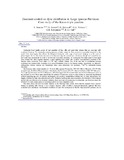| dc.description.abstract | Continental flood basalts consist of vast quantities of lava, sills and giant dyke swarms that are associated with
continental break-up. The commonly radiating geometry of dyke swarms in these provinces is generally interpreted as the
result of the stress regime that affected the lithosphere during the initial stage of continental break-up or as the result of
plume impact. On the other hand, structures in the basement may also control dyke orientations, though such control has not
previously been documented. In order to test the role of pre-dyke structures, we investigated four major putative Karoo-aged
dyke swarms that taken together represent a giant radiating dyke swarm (the so-called btriple-junctionQ) ascribed to the
Jurassic Karoo continental flood basalt (N3 106 km2; southern Africa). One of the best tests to discriminate between
neoformed and inherited dyke orientation is to detect Precambrian dykes in the Jurassic swarms. Accordingly, we efficiently
distinguished between Jurassic and Precambrian dykes using abbreviated low resolution, 40Ar/39Ar incremental heating
schedules.
Save-Limpopo dyke swarm samples (n =19) yield either apparent Proterozoic (728–1683 Ma) or Mesozoic (131–179 Ma)
integrated ages; the Olifants River swarm (n =20) includes only Proterozoic (851–1731 Ma) and Archaean (2470–2872 Ma) dykes.
The single age obtained on one N–S striking dyke (1464 Ma) suggests that the Lebombo dyke swarm includes Proterozoic dykes in
the basement as well. These dates demonstrate the existence of pre-Karoo dykes in these swarms as previously hypothesized
without supporting age data. In addition, aeromagnetic and air-photo interpretations indicate that: (1) dyke emplacement was
largely controlled by major discontinuities such as the Zimbabwe and Kaapvaal craton boundaries, the orientation of the Limpopo
mobile belt, and other pre-dyke structures including shear zones and (2) considering its polygenetic, pre-Mesozoic origin, the
Olifants River dyke swarm cannot be considered part of the Karoo magmatic event.
This study, along with previous results obtained on the Okavango dyke swarm, shows that the apparent btriple junctionQ
formed by radiating dyke swarms is not a Jurassic structure; rather, it reflects weakened lithospheric pathways that have
controlled dyke orientations over hundreds of millions of years. One consequence is that the btriple-junctionQ geometry can no longer be unambiguously used as a mantle plume marker as previously proposed, although it does not preclude the possible
existence of a mantle plume. More generally, we suggest that most Phanerozoic dyke swarms (including triple junctions) related
to continental flood basalts were probably controlled in part by pre-existing lithospheric discontinuities. | en_US |

